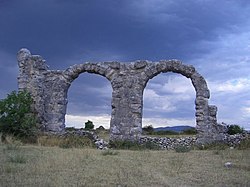Burnum: Difference between revisions
No edit summary |
No edit summary |
||
| Line 4: | Line 4: | ||
The Roman writer [[Pliny the Elder|Plinius]] wrote about Burnum, as "fortress distinguished in wars".<ref>Pliny, ''Historia Naturalis'' 3.141.</ref> The Pagana chart from the 16th century presented marked traits of Burnum as the ancient locality, but it did not reach archeological interest until the 19th century, when it occupied the attention of renowned Croatian archaeologists, father [[Lujo Marun]] and father [[Frane Bulić]]. The first excavations were conducted by Austrian archeologists. |
The Roman writer [[Pliny the Elder|Plinius]] wrote about Burnum, as "fortress distinguished in wars".<ref><ref>"Pliny, ''Historia Naturalis'' 3.141."</ref><ref></ref></ref> The Pagana chart from the 16th century presented marked traits of Burnum as the ancient locality, but it did not reach archeological interest until the 19th century, when it occupied the attention of renowned Croatian archaeologists, father [[Lujo Marun]] and father [[Frane Bulić]]. The first excavations were conducted by Austrian archeologists. |
||
It is assumed that Burnum originates from the year 33 B.C., but it is more likely that it was established a few decades later<ref> |
It is assumed that Burnum originates from the year 33 B.C., but it is more likely that it was established a few decades later<ref>2. J. J. Wilkes, ''Dalmatia'' (London, 1969) p. 87 ff.</ref>. Several Roman legions were located there in succession, and the first one was legio XX, placed already there in the beginning of the Pannonian uprising (''Bellum Batonianum'') AD 6-9.<ref>3. Velleius Paterculus, ''Compendium of Roman History'', 2.112.1-2.</ref> The reason for its location was the need for the control of traffic around the [[Krka River]]. Building was initiated by the Roman governor for Dalmatia [[Publius Cornelius Dolabella]] and continued by the Roman Emperor [[Tiberius Claudius Caesar Augustus Germanicus]]. |
||
The camp gained its final shape during the reign of Claudius around 50 A.D. [[Legio XI Claudia]] ''Pia Fidelis'' left the camp some times between A.D. 42 and 67, probably A.D. 56-57<ref>J. J. Wilkes, ''Dalmatia'' (London, 1969) pp. 96-97</ref> and was succeeded by [[Legio IIII Flavia Felix]]. |
The camp gained its final shape during the reign of Claudius around 50 A.D. [[Legio XI Claudia]] ''Pia Fidelis'' left the camp some times between A.D. 42 and 67, probably A.D. 56-57<ref>4. J. J. Wilkes, ''Dalmatia'' (London, 1969) pp. 96-97</ref> and was succeeded by [[Legio IIII Flavia Felix]]. |
||
According to some sources, a rebellion of L. Arruntius Camillus Scribonianus against the emperor Claudius was started at this camp as well.<ref>Dio, ''Roman History'' 60.15; Suetonius, ''Life of Claudius'' 37.2</ref> After the last Roman legions had left the camp, it developed into a settlement of urban type. |
According to some sources, a rebellion of L. Arruntius Camillus Scribonianus against the emperor Claudius was started at this camp as well.<ref>Dio, ''Roman History'' 60.15; Suetonius, ''Life of Claudius'' 37.2</ref> After the last Roman legions had left the camp, it developed into a settlement of urban type. |
||
| Line 15: | Line 15: | ||
[[1]]. Pliny, ''Historia Naturalis'' 3.141. |
|||
2. J. J. Wilkes, ''Dalmatia'' (London, 1969) p. 87 ff. |
|||
[[Category:Ancient Roman forts]] |
[[Category:Ancient Roman forts]] |
||
Revision as of 11:47, 15 November 2008

Burnum or Burnum Municipium was a Roman Legion camp or castra located near the village of Ivoševci, between modern Kistanje and Knin, Dalmatia.
The Roman writer Plinius wrote about Burnum, as "fortress distinguished in wars".Cite error: A <ref> tag is missing the closing </ref> (see the help page).Cite error: There are <ref> tags on this page without content in them (see the help page).</ref> The Pagana chart from the 16th century presented marked traits of Burnum as the ancient locality, but it did not reach archeological interest until the 19th century, when it occupied the attention of renowned Croatian archaeologists, father Lujo Marun and father Frane Bulić. The first excavations were conducted by Austrian archeologists.
It is assumed that Burnum originates from the year 33 B.C., but it is more likely that it was established a few decades later[1]. Several Roman legions were located there in succession, and the first one was legio XX, placed already there in the beginning of the Pannonian uprising (Bellum Batonianum) AD 6-9.[2] The reason for its location was the need for the control of traffic around the Krka River. Building was initiated by the Roman governor for Dalmatia Publius Cornelius Dolabella and continued by the Roman Emperor Tiberius Claudius Caesar Augustus Germanicus.
The camp gained its final shape during the reign of Claudius around 50 A.D. Legio XI Claudia Pia Fidelis left the camp some times between A.D. 42 and 67, probably A.D. 56-57[3] and was succeeded by Legio IIII Flavia Felix.
According to some sources, a rebellion of L. Arruntius Camillus Scribonianus against the emperor Claudius was started at this camp as well.[4] After the last Roman legions had left the camp, it developed into a settlement of urban type.
The camp completely destroyed when Justinian attempted to take it back from the Ostrogoths in the 6th Century.
